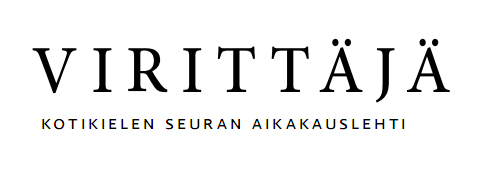Eläinaiheiset luonnonkasvien nimet kansankielessä
Avainsanat:
kasvinnimet, sanastontutkimus (ks. myös lainasanat, leksikografia, sanahistoria), terminologia (ks. myös kielioppiterminologia)
Abstrakti
Animal themes in vernacular names of wild-growing plants (englanti)2/1998 (102)
Jarna Karhu
Animal themes in vernacular names of wild-growing plants
In the article the writer discusses the vernacular names of wild-growing plants that include the name of an animal, such as koiranputki (koira 'dog'; Engl. 'cow parsley'), kissankello (kissa 'cat'; Engl. 'harebell') and hevonhierakka (hevonen 'horse'; Engl. 'northern dock'). Most animal-themed plant names are compounds whose modifier is the genitive form of an animal name, and whose principal element is a nominal with the meaning of a plant. The most commonly occurring animals in vernacular plant names are hevonen, nauta 'bovine animal' (also hrk 'ox, bull', lehm 'cow', mulli 'bull calf'), koira, harakka 'magpie' and sika 'pig'.
Animal-themed names have been used above all for plants which are not useful to man, and in particular for plants which are not fit to eat especially berries. For example variksenmarja (Engl. 'crowberry', Empetrum nigrum) has commonly been called harakanmustikka, karhunmustikka, kissanmustikka or sianmustikka (mustikka 'blueberry, bilberry', modified by magpie, bear, cat and pig, respectively). From these names it is clear that variksenmarja has been compared with the edible berry mustikka.
There are also many names which have been motivated by the shape of the plant or a part of it, for example the name koirankieli (kieli 'tongue'; Engl. 'hound's-tongue') is motivated by the plant's oblong leaves, and hrnsilm (silm 'eye'; Engl. 'cat's-ear') by the bright-coloured flowers or blossoms. If the name features hevonen, hrk or karhu, this could indicate that the plant is large in size. Correspondingly, hiiri 'mouse', kissa and lintu 'bird' often suggest smallness or slenderness. A plant name may also feature the name of the animal for which the plant has been used as medication or food, or which can be driven away using the plant. Some plants, on the other hand, which grow either in water or wet places may have fish-themed names. Folk etymology, too, has played a part in the creation of some animal-themed names, for example the name kamomillakukka 'camomile flower' has given rise to kamelinkukka (kameli 'camel').
The writer has analysed the age of animal-themed names by searching for their Estonian equivalents. Estonian dialects contain so many exact equivalents for the Finnish names that it is possible to conclude that at least a proportion of the animal-themed plant names have their origin in the Proto-Finnic period. Animal themes are also included in many formal plant names. Popular amongst these are the names of undomesticated animals, in contrast to the domestic animals more popular in vernacular names. The most popular animals in formal plant names are kurki 'crane' and koira.
The greatest influence on the establishment of Finnish names for wild-growing plants has been Elias Lnnrot. In Lnnrot's Flora Fennica (1860), plants were given formal Finnish names for the first time. Lnnrot turned many vernacular names into formal plant names, amongst them sianpuolukka (Engl. 'bearberry'), harakankello (Engl. 'spreading bellflower') and variksenmarja. Lnnrot also translated many Swedish and scientific plant names into Finnish and coined names himself using structural models from vernacular names.
Viittaaminen
Karhu, J. (1998). Eläinaiheiset luonnonkasvien nimet kansankielessä. Virittäjä, 102(2), 184. Noudettu osoitteesta https://journal.fi/virittaja/article/view/39052





